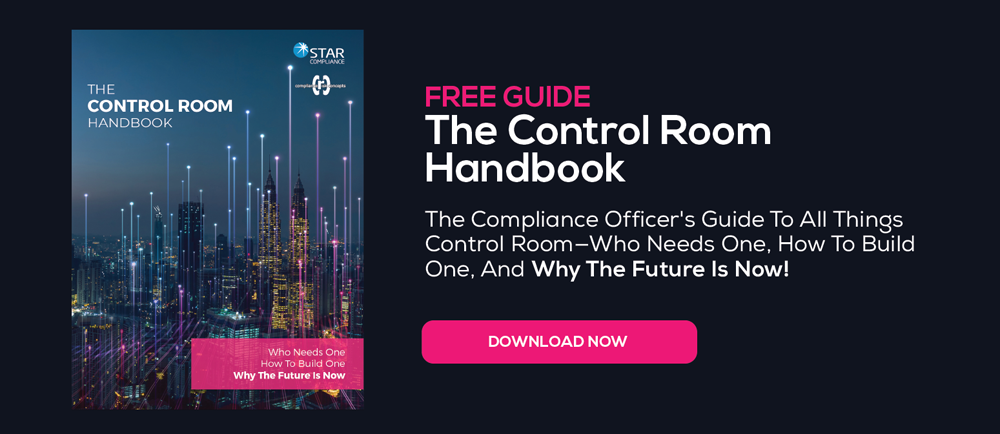Should you buy control room software from a third-party vendor or build it in-house? Asking these three key questions can start you in the right direction
Chief compliance officers and other firm leadership are responsible for determining exactly how to monitor for insider trading, and putting processes in place to reduce the chances of market abuse occurring in the first place. Regulatory guidelines on the matter are actually quite limited; regulations state only that firms need “adequate policies and procedures in place to prevent and detect insider trading.”
The specifics around how this monitoring happens depend on the type and level of activities in which your firm engages. For example, activity that results in a high volume of material nonpublic information, or MNPI, being generated may necessitate advanced controls for greater oversight. Control rooms are one compliance function that can bring such oversight, and control room software can help compliance teams scale the management of MNPI as their firms grow and engage in more deals and services.
THE BUILD VS. BUY SOFTWARE DECISION
For firms that do need control room functions to adequately monitor the flow of MNPI, the question for leaders then becomes: Do you buy control room software from a third-party vendor or do you build it in-house? Although there are many factors to consider, starting with these key questions can set you off in the right direction:
1. WHAT WOULD IT COST TO BUILD?
Building a custom software solution requires a significant investment of time and money. Assess what the initial investment will look like by breaking down the total cost of ownership, or TCO, into the following categories:
- Software: licensing for operating systems, databases, applications, development environments, and the associated maintenance agreements for regular upgrades
- Hardware: equipment such as servers, storage, desktop computers, racks, power, routers, and other network devices, including the cost to rent space in a secure data center
- People: salaries and professional-services fees, organizational overheads, training, and other costs associated with the people who develop, run, and support the solution
- Redundancy: costs of ensuring adequate coverage for each of the above components should any become unavailable
Note that the cost to build doesn't stop once the software is completed. You will incur some of the above costs—such as data center and space salaries—year-over-year. This may sound obvious, but many overlook this consideration as they calculate TCO.
2. WHAT WOULD IT COST TO BUY?
If you're thinking of buying control room software from a vendor, first gain a solid understanding of the entire package to ensure its functionality will meet your current and future needs. For example, if updates aren't included in the subscription price, you may need to pay more each time the vendor releases enhancements. Typically, however, a vendor will charge a one-time implementation fee, a yearly licensing fee, and potentially a fee for hosting your data, depending on your firm's hosting requirements. Read the fine print and compile a list of questions to ask the vendor before moving forward. Pay close attention to the following areas:
- Software Licensing: Examine the terms and conditions of the software in question. Are the fees per seat or flat? Will the licensing agreement be a subscription or perpetual?
- Implementation: Understand how long it will take to install and integrate the solution. The goal is to minimize disruption to operations during the implementation process.
- Integration: Confirm that the vendor will be able to integrate with existing systems such as HR, firm-trading, open-order, and broker-dealer systems.
- Configuration: Is the product configurable to meet the specific needs and challenges of your organization?
- Security & Storage: How does the vendor back up its records. Will you be able to access necessary documentation if an audit occurs? How quickly will you be able to do it?
- Translation/Localization: If your organization operates globally, consider legal, linguistic, and cultural implications. Does the vendor have experience meeting the specific software and interface challenges of global operations?
- Maintenance & Support: Performance issues are inevitable, and organizations will want to clarify how the vendor handles such situations both large and small. Will the vendor be able to provide immediate action when needed?
If your firm opts to build control room software, you have total ownership of the platform and the control to adapt it to meet the exact needs of your organization. You also have team members at your beck and call who understand every aspect of the software. With this ownership, however, comes accountability. If a big-ticket item is missed during development, for instance, it’s up to the in-house team to fill the gap, which means it could take months before a solution can be made available within the system. This accountability also involves staffing, as it will take a very targeted discipline to adapt and maintain a proprietary system as an organization grows.
With the purchase of control room software, organizations earn freedom. In order to survive, vendors must continually update and improve their product offerings and maintain the expertise of their teams. It’s the vendor's responsibility to ensure the system stays moving in the right direction and to troubleshoot it should problems arise. You also benefit from the ideas and feedback of a community of users that is literally helping drive the product roadmap; this means new use cases, features, and functionality you may never have thought of are being incorporated into your control room software on a continual basis. The build-versus-buy decision isn’t black and white, but taking the time to weigh the pros and cons of each option will help you make the best-informed decision for your firm. 


